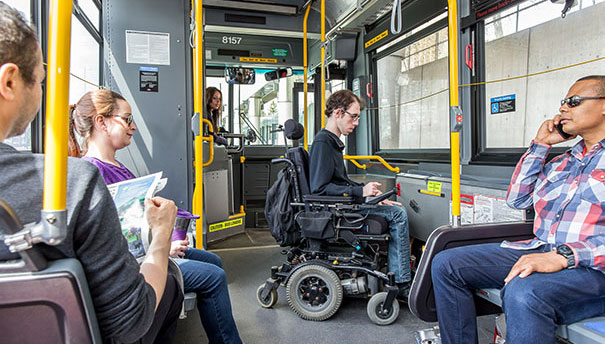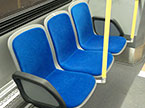Riding the Bus

How to recognize an accessible stop
You can recognize an accessible bus stop by the blue international wheelchair symbol located on the red and white stop pole. Not all bus stops on an accessible route are accessible.
Route and destination announcements
All buses verbally announce the route and destination of the vehicle to customers waiting at each stop when the front door opens. This information is also displayed visually on the vehicle’s front, side, and rear destination signs. If you do not hear, or see, the automated announcements, please tell your Operator and ask for the route and destination of the vehicle.
Using the ramp
All TTC buses are equipped with a ramp at the front door and have the ability to kneel, or lower the bus, at the front door. Anyone who feels they can benefit from the use of the kneeling feature or ramp may request they be activated. These features can assist people who:
- Use wheelchairs or scooters.
- Use other mobility aids, such as walkers, crutches or canes.
- Do not use a visible mobility aid, but who would benefit from using a ramp, such as seniors or people with strollers.
You can request access to a ramp by directly asking the Operator to activate the feature, or as the bus is slowing down, show your blue Accessible Flashcard. The card lets Operators know that you need to use the ramp. Accessible Flashcards are available by contacting TTC Customer Service by phone at 416-393-3030 or TTY at 416-338-0357, Wheel-Trans Customer Service at 416-393-4111 or TTY 416-393-4555, or from Collectors and Customer Service Agents at subway stations
Riders who request the use of a ramp should board and exit their accessible bus at an accessible stop. You should expect to board from or exit to the widest part of the sidewalk, which will be immediately beside the stop pole at the vast majority of bus stops. However, at locations with narrow sidewalks, the accessible boarding location may be up to 3 metres before or after the stop pole, or you may be asked to board from within a bus shelter. In the event that the bus stop that you want to exit at is not designated as accessible due to limited sidewalk space, your Operator will attempt to locate a nearby safe drop off location, or inform you of the next accessible stop on the route.
At a crowded bus stop, Operators are instructed to allow customers using wheelchairs or scooters to board first. But when disembarking, those customers are requested to exit the bus last.
First on, last off
Customers using a mobility device are encouraged to board our vehicles first, before other customers and exit last, before others leave. Customers should be mindful of this when they see people using a mobility device.
Paying fares
When you board the bus, pay your fare as you pass the farebox, or show Tap your PRESTO card or PRESTO Ticket on the card reader. Operators are permitted to assist with placing your fare into the fare box if you cannot reach it. If you are paying with cash, tickets, or tokens, ensure that you take a transfer, which is your Proof of Payment (POP). Your tapped PRESTO card is your POP.
Wheelchair and scooter positions
All accessible buses have two onboard positions at the front of the vehicle for customers using mobility devices such as wheelchairs and scooters.
Buses are designed to safely permit the passage of a mobility device 1,220 mm long (48 inches) by 760 mm wide (30 inches) through the entrance, past the fare box, to the mobility device seating positions, which are designed to accommodate devices up to this size. Each model of bus is designed slightly differently to meet this requirement. There is no specific mobility device turning radius that the buses are designed to accommodate. The aisle width of most TTC buses through the fare box area ranges from 800 mm (31 inches) to 880 mm (34 inches).
When the bus arrives at the stop, the Operator will ask you if you want to be secured. If your answer is yes, then the Operator will prepare the mobility device position. If you choose to be secured, the Operator must use the full securement system. The only exception is if you transfer to a seat, then your mobility device must be secured. You must position yourself in the mobility device area facing forward, turn off all power and apply the brakes on your mobility device. Proper securement is required for your safety, and for the safety of others on the bus.
Please note: When boarding accessible vehicles, customers using mobility aids must be safely in the mobility device position before the Operator stows the ramp. Similarly, when disembarking, customers using mobility aids must remain in the mobility device position until the ramp is deployed.
Customers using mobility devices must not have excessively protruding baggage or packages, and the mobility device must be properly balanced at all times. Heavy objects should not be slung across the rear handles or carried in any other manner that could cause an imbalance or loss of control.
Priority seating for seniors and persons with disabilities
In accordance with the Accessibility for Ontarians with Disabilities Act 2005 (AODA), TTC provides Priority Seating on all of its vehicles, designated for use by persons with disabilities. You must give up these seats for a person with a disability or has a physical limitation requiring priority seating. A customer with a disability occupying a priority seat is not required to move for another customer with a disability. In this situation, use of these seats is on a first-come, first-served basis. You are not required to give up your seat that is not designated priority seating. TTC encourages customer co-operation particularly as it relates to giving up seating for people with disabilities, elderly customers, and pregnant women.

Seats with blue fabric are designated priority seats. TTC By-law No 1 requires that you obey signs posted by the TTC, including Priority eating signs on TTC vehicles. Persons who do not comply with Priority Seating signs may be subject to penalties under this By-law and liable to a fine of $235.00 plus applicable charges.
Decals also indicate where priority seating is located. It is generally located near the entrance of vehicles.
More information can be found in the Priority Seating FAQ.
Automated Stop Announcements on buses and streetcars
All buses and streetcars are equipped with automated next stop announcements to verbally and visually display the upcoming vehicle stop. If you do not hear, or see, the automated announcements, please tell your Operator what your planned destination is and ask him or her to let you know when you have reached your stop.
Request Stop Program
The Request Stop program is available to all customers travelling alone by bus between 9:00 p.m. and 5:00 a.m. Request Stop allows any customer feeling vulnerable to get off the bus between regular TTC stops.
- The request should be made at least one TTC stop ahead of the desired location.
- The Operator must be able to stop safely in order to meet your request.
- Exit the bus via the front doors, the rear doors will remain closed.
Reminder: Request Stop is not available on streetcars. Streetcars travel in the middle of the roadway too far from the sidewalk to let customers exit the vehicle safely at an unmarked stop.
Stops between stops
TTC Operators may exercise discretion when it comes to stopping their bus between regular TTC stops for any customers expressing a genuine need to exit the vehicle, regardless of gender or time of day. The only restrictions are:
- Whatever the location, the TTC vehicle must be able to stop in a safe manner.
- Whatever the reason to stop between stops, the person making the request must truly be in need (i.e., personal safety or disability).
Surface vehicle camera system
All buses and streetcars are equipped with cameras to record activity that takes place within the vehicle. The cameras help to enhance customer and employee safety, and aid police in conducting investigations. For more information, visit Safety and Security.
Blue Night Network
The TTC operates a late-night bus service called the Blue Night Network. Buses run from about 1:30 a.m. to 5 a.m. (8:00 a.m. on Sundays) on many major routes. For more information, visit Schedules and Maps.
Community Bus Network
The Community Bus is an accessible, kneeling, fixed-route bus service aimed primarily for seniors and others who have some difficulty accessing the conventional transit system. Anyone may ride a Community Bus at regular TTC fares. Community Bus routes generally operate on weekdays, from about 10:00 a.m. to 5:00 p.m. All Community Buses serve local bus stops along the route, but they can also be flagged down at any point along the route. For more information, visit Schedules and Maps.

